Outline of ProgrammeX
| 6. Business and ICT Transformation |
Cap Gemini has an approach for the technology-enabled transformation of the business that is appropriate for major changes in both the business and ICT system of a company. This transformation approach serves as context for the different workstreams of ProgrammeX.
The Cap Gemini transformation approach has the following characteristics:
- Alignment between the Transformation of Business and ICT
The transformation approach is aimed at major business and ICT changes over a longer period of time. The objective of the transformation is to achieve business benefits thanks to new or renewed business supported by fundamentally different ICT services. The transformation is realised through a programme of delivery projects.- Solution aimed at business benefits
Most current development processes are still aimed at partial solutions. Some part of the business process is renewed with the support of a stand-alone IT solution. The Cap Gemini approach sees both the business and the ICT system as a network. The business part of the solution must be aimed at the renewal of a coherent part of the business process, for example a supply chain for the delivery of some type of product. When the company uses suppliers for components of the product, the redesign also includes the communication and co-operation with the suppliers in the whole supply chain. The same holds true for the supporting ICT system. This is a computer network with distributed applications. Communication and co-operation between computers and applications in the network must be carefully designed. When different companies form a supply chain for the delivery of a product it is better to extend the redesign to the whole common supply chain. This means a redesign of the ICT systems of all the companies involved.- Transformation Programme for Iterative, Incremental and Interactive Delivery
The delivery of the complex transformations in both business and technology can only achieved in an iterative and incremental way: the solution grows in a number of iterative transformation cycles to the final solution. The Cap Gemini approach organises the change process as a programme of projects that are executed both serially and in parallel over a longer period of time. Each project corresponds to the renewal of a part of the business and/or the supporting ICT system. The resulting new business and ICT system grow in an incremental way. This differs strongly from the conventional approach, which organises a transformation, especially the development of information systems, as a single large linear project. During the delivery of the business and ICT transformation business experts, ICT experts and customers work interactively together in multidisciplinary teams.
The next paragraphs describe the main features of the Cap Gemini transformation approach.
6.1 Transforming the Organisation
In the book Transforming the Organization Gouillart and Kelly give a description of the vision of Gemini on business transformation. This paragraph describes some highlights of this vision.
The company as living organism
The underlying premise of business transformation is that the complexity of a modern corporation defies mechanistic description, that a corporation is tantamount to a living organism- the biological corporation. Companies are living, volitional beings - like people - with body, mind and spirit. Companies are born, they grow, they get sick, they recover, they mature and they grow old. Companies think, they choose, they learn, they work, they feel. And like people, companies are mortal - they can die. Unlike our own demise, however, theirs is not inevitable. For the biological corporation, we belief the secret of a very long life resides in its ability to orchestrate the simultaneous transformation of all its systems in a unified pursuit of common goals.
Increased Connectivity in the Communications Age
The corporation as living organism means a fundamental shift in how managers and employees view their organisation. Our current model of organisation, born in the Industrial Age is a mechanistic one. Corporations have been agents in an efficient market system, parts of an ever expanding, even more complex machine. We are now entering the Information and Communications Age. It is time to replace our mechanistic view of business with a more organic one.
We are moving beyond the Industrial Age, but our business model is still rooted there. A lot of people say that the ability that information technology gives us to manage the flow of information represents the basis for the new business model of the Information Age. As shown in chapter 3, there is more involved than that. The revolution in communications technology is merely the facilitator of a more fundamental social and business influence: an unstoppable trend toward increased connectivity. So Communications Age is a better term than Information Age.
Corporations in the Communications Age
The age ushered in by the Industrial Revolution and lasting until our own time was largely driven by technology, but its most important manifestations were social. The rhythm of life changed profoundly, and because the spirit of the Industrial Age was mechanical, the qualities of the social institutions it created (bureaucracy, hierarchy, command-and-control system and specialisation) were machine-like as well. The line worker became a cogwheel in the clockwork of the organisation, with no sense of personal connection to the company and with no feeling of communion with the environment.
And so the Communications Age is upon us, replacing the Industrial Age. As was true in earlier social transformations this one is increasing the level of social complexity and leading to profound changes in society, to which the company – the dominant institutional creature of the Industrial Age – must adapt. ICT will let grow our networks inexorably in both size and complexity. This is true not only for individuals but also for corporations. Companies will form ICT enabled alliances and partnerships with their suppliers and customers, becoming parts of networks, and even networks of networks. Companies become part of Web Enterprises, the physical and financial boundaries between companies are blurring.
But while the individual networks expand, and while business networks become knowledge networks, there is a human element that warrants careful attention. Connectivity can be a double-edged sword, triggering either greater individual isolation or a greater sense of community, depending on the role companies and other organisations choose for themselves in the future.
On the pessimistic side, increased connectivity, especially of the electronic variety, may cause a loss of genuine human contact. We do not feel longer emotional about the people we interact with. In companies the economic logic takes over. Old social contracts expire and are replaced by more Darwinian models of individual survival. Everyone becomes master of his own destiny. Employees see no longer the company as their common destiny. The company no longer cares for his employees; it simply hires them when needed.
Another more optimistic scenario is possible. Corporations can provide a new caring. This will not happen in the paternalistic fashion of the hierarchical corporation, but it will happen in different forms. Successful corporations will develop a new role built around the invention of a new social contract. Corporations will take responsibility for the renewal of individuals, helping them to acquire new skills. Corporations will redefine the boundary of their responsibilities, accepting accountability for the way they use resources and contribute to their environment. Most importantly, companies will build a new pride in the people who are part of them.
The four R's of Business Transformation
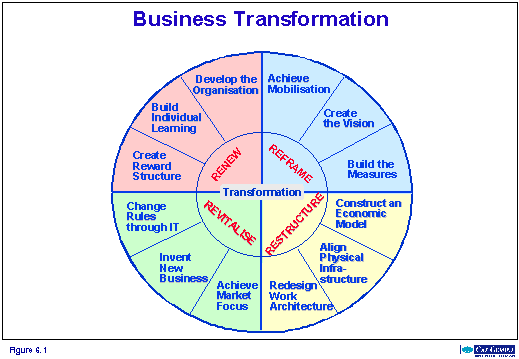
"Transforming the Organization" introduces a biological model of Business Transformation (see picture). This form of Business Transformation is aimed at transforming current companies to the biological corporations of the Communications Age. The model consists of four categories of change called The Four R's of Transformation: Reframing, Restructuring, Revitalisation, and Renewal. Each R is divide in three chromosomes. These 12 "chromosomes" comprise the corporate genome. Each chromosome spawns a biocorporate system that is described in the book.
Business Transformation is defined as the orchestrated redesign of the genetic architecture of the company, achieved by working simultaneously – although at different speeds – along the four dimensions of Reframing, Restructuring, Revitalisation, and Renewal.
Reframing is the shifting of the company's conception of what it is and what it can achieve. It addresses the corporate mind. Corporations often get stuck in a certain way of thinking, and loose the ability to develop fresh mental models of what they are and what they could become. Reframing opens the corporate mind and infuses it with new visions.
Restructuring is a girding of the corporate loins, getting it to achieve a competitive level of performance. It deals with the body of the corporation. The need to be lean and fit is the primary consideration. Restructuring is the domain where the payoffs are fastest and the cultural difficulties are greatest, often making layoffs and the anxieties associated with them an unavoidable side effect. The payoffs, however, if invested in revitalisation and renewal, can be used to heal the wounds, if not to lessen their severity. Many companies stop at restructuring cajoled into contentment by their "quick wins". But they will not gain true health unless they use the wins to fuel longer-term transformations programmes.
Revitalisation is about igniting growth by linking the corporate body to the environment. Everybody wants to grow, but the sources of growth are often elusive, making the process of achieving growth more challenging and protracted than restructuring. Of all the four R's, revitalisation is the single greatest factor that clearly distinguishes transformation from mere downsizing.
Renewal deals with the people side of the transformation, and with the spirit of the company. It is about investing individuals with new skills and new purposes, thus allowing the company to regenerate itself. It involves creating a new kind of metabolism, the rapid dissemination of knowledge inside the firm, and it involves cultivation of a reflex of adaptation to environmental changes. Renewal is the most subtle and difficult, the least explored, and potentially the most powerful of the transformation dimensions.
6.2 Major Changes in Business and ICT
The transformation approach of Cap Gemini is not specifically aimed at the transformation of companies to the ICT enabled Web Enterprises of the 21st Century. Companies already need today an approach to manage major changes in an integrated way.
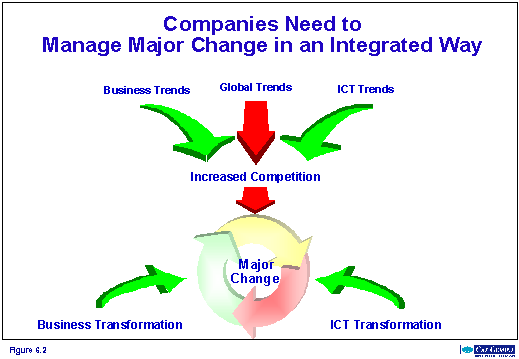
Companies are faced with a lot of changes in their environment. Examples are major trends like globalisation, mergers and privatisation, and business trends like changes in their business sectors, developments in the markets and increased competition. Al these trends force companies to adapt and respond quickly. The development of new products and services, and the design of adequate, flexible business processes, purchasing channels and sales channels are therefore becoming increasingly important.
ICT is often a useful resource to support the business changes but ICT itself is also fast developing. New technologies emerge and offer new services to the business. This causes a lot of questions. Will these services offer the possibility for new or renewed business processes? Must the current technology infrastructure be renewed or replaced? Are our technology choices the right ones? Which technologies will become the standard?
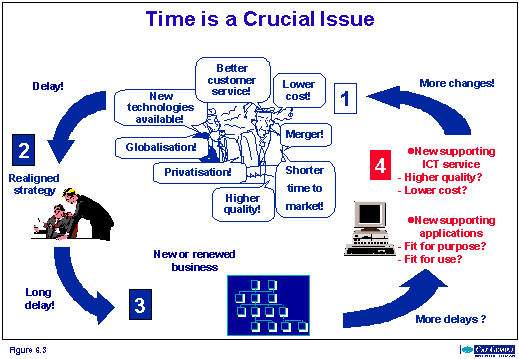
The trends force companies to major changes in their business and ICT. These changes are even larger when companies decide to change their strategy and to develop and introduce new products and/or services.
The result is that companies need a way to manage a transformation in both business and ICT in a coherent and integrated way.
Time is a crucial issue in the transformation approach. An adaptation to the external trends includes:
- Translation of new technology in new or renewed business opportunities
- Translation of the business and ICT trends in a realignment of the strategy.
- The design and implementation of new or renewed business processes.
- The design and implementation of new or renewed ICT applications in support of the business.
All these steps are prone to delays. Companies therefore need a transformation approach that prevents delays that could occur during the transformation. The best way is to take all major decisions about strategy, technology, business and ICT applications in an early stage before the transformation itself is started.
6.3 The Cap Gemini Transformation Approach
The Cap Gemini transformation approach is developed especially for large and complex changes in both the business and the supporting ICT system. In this case we are referring to changes so large that the transformation cannot be realised in one project, but only through a programme of projects, that realise both serially and in parallel the whole transformation.
The whole approach is aimed at managing complex transformations and at delivering the solution on time and above customers' expectation.
The objective of a transformation programme is to achieve business benefits thanks to new or renewed business supported by fundamentally different ICT services.
The transformation starts with the definition of the solution of the transformation.
A joint team of employees of the customer and professionals of Cap Gemini addresses a fundamental business issue by:
- identifying the business aspects and ICT aspects to be established or renewed;
- quantifying the benefits of implementing the change.
The result is the agreed solution.
This agreed solution is realised by a transformation programme that implements the change in the form of new or renewed business and ICT systems and realises the expected business benefits.
Cap Gemini supports the complex transformation life cycle of business and ICT with the following methods:
- Gemini's Analysis and Design (A&D) for the definition of an agreed solution focused on Business Transformation, e.g. changes in the client's strategic paradigm or portfolio of activities.
- Cap Gemini's SCOPE for the definition of an agreed solution focused on Systems Transformation, i.e. new or renewed ICT services applied to new or reengineered business processes.
For a transformation of both the business and ICT a combination of the A&D and SCOPE approach supports the definition of an agreed solution for major changes in both business and ICT.
- Programme Management
This is the management of a coherent process of significant business and ICT change, across business areas, involving multiple projects and services, to achieve common business objectives and where success is measured by realisation of significant business benefits.
6.4 The Transformation Life Cycle
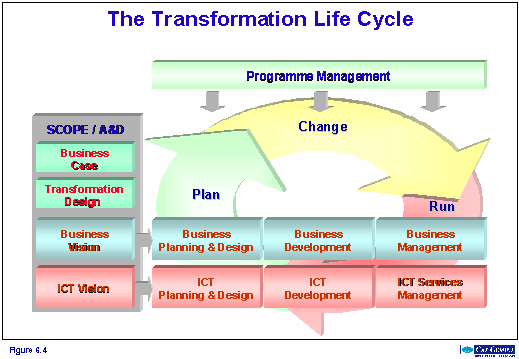
The transformation approach is depicted in the above transformation life cycle.
The life cycle starts with the solution definition based on the SCOPE and/or A&D followed by the plan-change-run cycle of:
- Delivery projects, which design, develop and deploy the changes and together achieve the transformation.
- The run phase, where the new or renewed business and supporting ICT systems are operational and the business benefits of the transformation are assessed.
The plan-change-run cycle is divided in two main areas:
- the business, with changes in business aspects such as organisation, commerce, products, processes, information, personnel and finance;
- the ICT system, with aspects in changes such as applications, data and technology infrastructure.
The transformation cycle is:
- Incremental: the whole transformation is realised in a number of stages, which realise a part of the solution.
- Iterative: business management and ICT services management assess the results of each stage during the run phase. When the solution does not fully meet the expected business benefits, improvements are designed and developed in the next stage of the transformation.
The management of the whole transformation life cycle is the task of Programme Management.
6.5 SCOPE
The SCOPE is aimed at the definition of the solution of the transformation. The SCOPE is the first step of the transformation and results in a global planning and design of the whole transformation. The SCOPE ends with the decision by the customer to start or not to start the proposed transformation.A joint team of employees of the customer and professionals of Cap Gemini is working together in realising the SCOPE.
The SCOPE focuses on an important business issue for the customer. An excellent issue for a transformation is for example the renewal of a complete supply chain of a product or service of the customer.
The SCOPE defines the solution in the following deliverables:
- A Process Vision consisting of AS-IS description and TO-BE vision of the supply chain and key processes. With Gemini's A&D this Process Vision may be extended to a Business Vision which also covers other business aspects.
- An ICT Vision consisting of:
- an AS-IS analysis of ICT aimed at the current role of ICT in the business, the systems structure and the ICT organisation;
- a TO-BE Vision of ICT aimed at the applications to improve, develop, acquire or remove, at the renewed technology infrastructure and at the changes in ICT Services Management.
- A Transformation Design describing the change areas and phases of the change programme and a preliminary plan for the Programme Management workstreams.
- A Business Case, which describes the business benefits of the transformation in the form of quantified and measurable improvements.
The Cap Gemini Architecture is used to make a global design of the business and ICT system that supports the TO-BE business and ICT vision. This design acts as a city plan of the future business and ICT system. The design divides the whole business into business areas with supporting ICT services and defines the interfaces between the different areas. The global design makes it possible to design and develop the changes in the business areas in parallel or in a series over a longer period and still have the guarantee that they eventually fit together.
In our example of the virtual bank, the figures of the business, information system and technology infrastructure can be viewed as three global maps corresponding to the city plan of the business and ICT system of the virtual bank.
The transformation design may contain some different scenarios for the transformation based on different expectations of future developments of business and ICT, for instance different market developments for the business or the availability of certain types of technology in the near future.
The whole SCOPE is aimed to support the decision-making about the transformation. All deliverables together give a high level description of the results, the costs and the business benefits of the transformation. The SCOPE team only investigates or describes details when necessary to support a soundly based decision by the customer.
The last step in the SCOPE is the decision by the customer to start or not to start the proposed transformation.
6.6 Programme Management
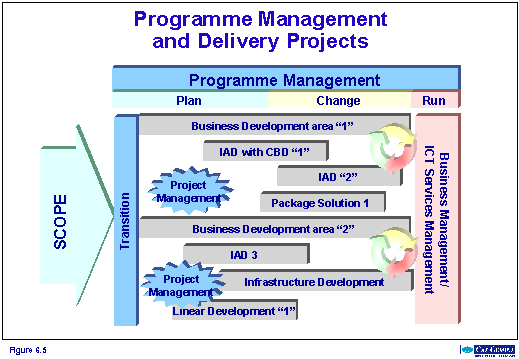
Programme Management is the method for managing the transformation programme of a large transformation of business and ICT as defined by the solution of a SCOPE and/or A&D.
The Transformation Programme is a coherent process of significant business and ICT change, across different business areas and involving multiple projects and supporting services, to achieve the business and ICT vision as defined in the solution. The success of the transformation is measured by the realisation of the business benefits as defined in the business case of the solution.
The programme management is the task of a programme manager assisted by a programme management team. The programme manager is the key officer responsible for the realisation of the transformation.
The transformation programme consists of delivery projects, which are executed both serially and in parallel. Each project delivers a part of the transformation.
The projects deliver for example the process changes in the different business areas, ICT applications or a part of the technology infrastructure.
The application development projects may use different approaches such as:
- A linear approach for back-office transaction systems, which need a careful design prescribing the structure and functionality of applications and data.
- A package based approach for the customisation and implementation of application packages.
- An iterative application development approach (IAD) for the delivery of applications which need customer interaction and prototyping during the development in order to establish the necessary functionality. For instance front office and middle-office applications where usability for the end-users is important.
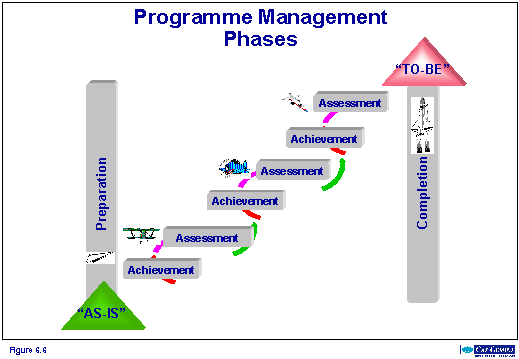
The above picture depicts the phases of Programme Management:
- Preparation: establish the programme details and confirm the objectives and strategy.
- Achievement: the projects realise the design and development of the programme deliverables of business, ICT and people change.
- Assessment: review how well the results of the projects are performing and what needs adjustment.
- Completion: ensure managed ramp-down to realise long-term benefits to the customer and Cap Gemini.
The programme as established in the preparation phase, defines the global result and the planning of the delivery projects. The programme synchronises the changes in business and ICT. The planning of the projects is based on the following arguments:
- Business benefits are leading. The changes that are most useful for the business are addressed first. This results in early business benefits.
- Availability of required staff (both business and ICT), of the required technology and of the necessary knowledge and experience.
- Normally a project takes no longer than 6 months. With Component-Based Development the delivery projects for applications will be considerably shorter.
- Risky changes must be done first on a minor scale. For instance new technology must first be applied in a pilot situation before full-blown application in a business critical situation.
The projects within the program are grouped in achievement/assessment cycles. The result is an iteration of transformation cycles each consisting of an achievement and assessment phase. Each cycle realises and evaluates a next stage in the transformation. These stages act as islands of stability in the way from the AS-IS situation to the TO-BE vision.
The result of the achievement/assessment cycles are deliverables feasible in the short term, all of which contributing to realising the long-term objectives and business benefits as defined in the agreed solution.
The deliverables of the phases of programme management are grouped in workstreams, which focus on the following aspects:
- Leadership and communication within the projects.
- The realisation of the business benefits.
- The client relationship.
- The availability of the required people and resources.
- Integration of the different projects and their results.
- Governance i.e. all planning, management, monitoring, control and auditing activities.
Programme Management may adapt the transformation programme when there are changes in the business requirements, when new or better technology becomes available, or when the intermediate results of the achievement/assessment cycles does not meet the expectations. The results and planning of the rest of the programme are redefined and projects may be included to adapt the already operational parts of the business and ICT. In the case of large changes even a "rescoping" is possible. The SCOPE is repeated and a new adapted transformation programme is defined.
6.7 The Competencies of ProgrammeX in the Transformation Life Cycle
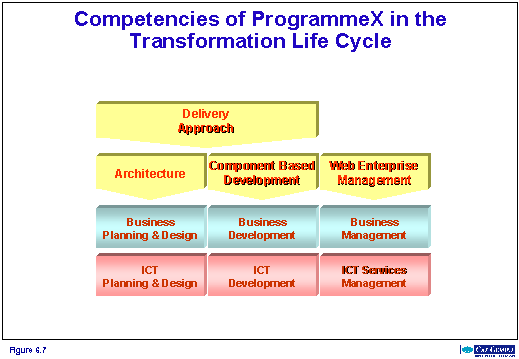
The transformation approach services as background for the development of new competencies within ProgrammeX. The picture provides an overview how the four workstreams of ProgrammeX influence the business and ICT system life cycle.
The Web Enterprise Management will be a new approach of integrated Business and ICT Management specifically aimed at the virtual, agile and adaptive Web Enterprise.
Architecture plays the most important role in supporting the design of the new or renewed business and supporting ICT system.
Component-based software development influences the ICT Development. It supports a fast and incremental path for the development of complex distributed information systems.
The Delivery Approach influences the planning, design and development of the business and ICT transformation.